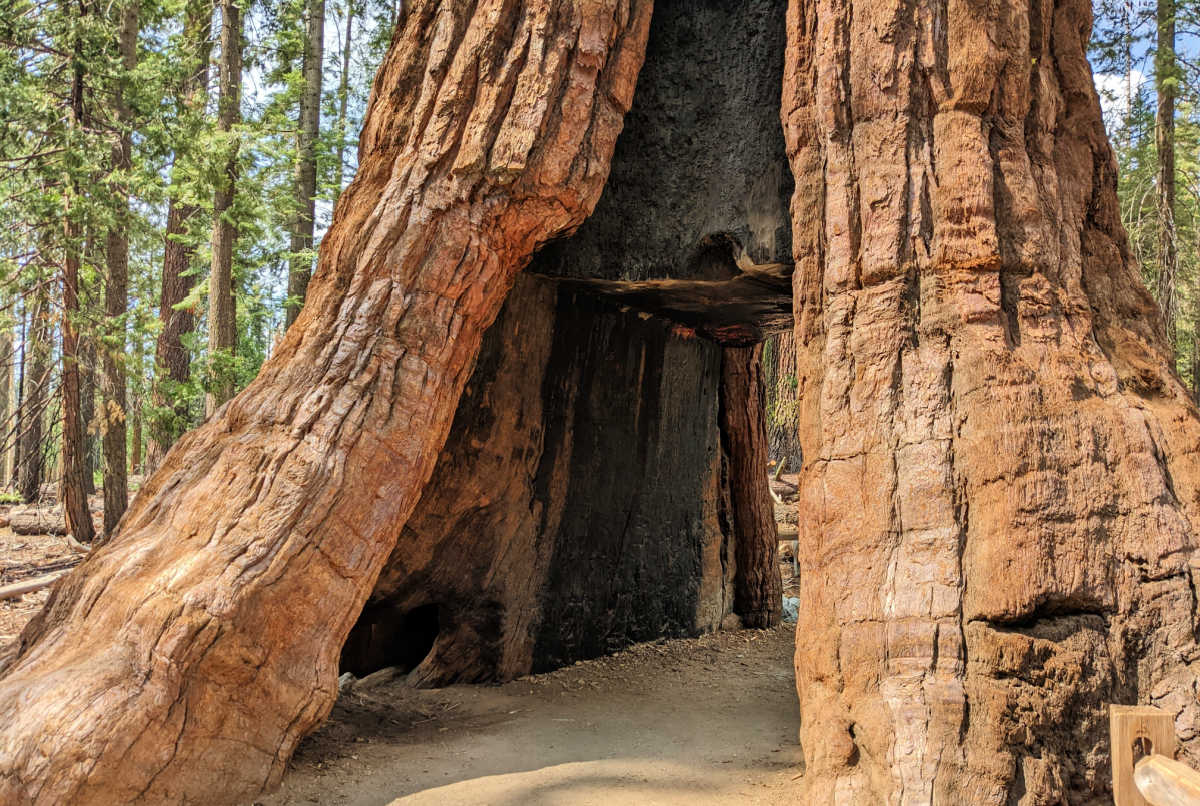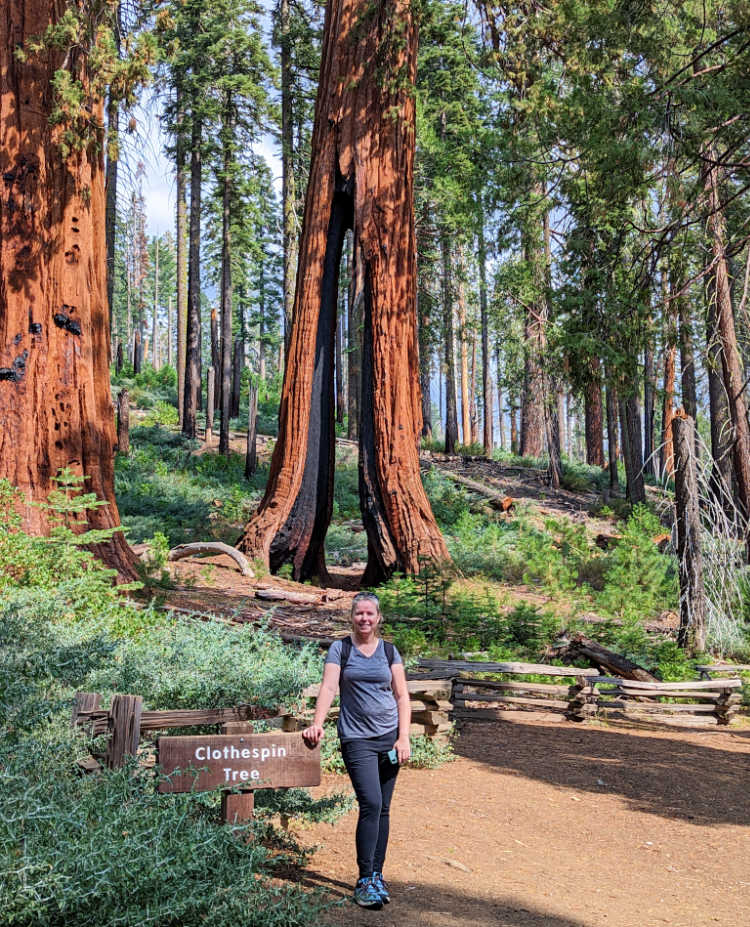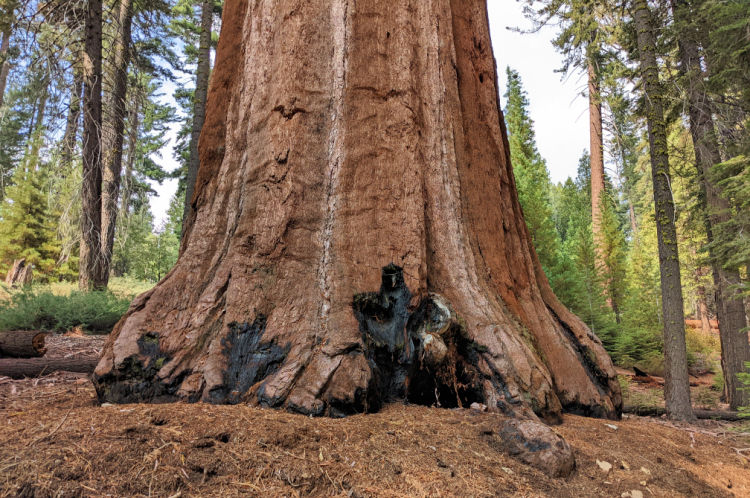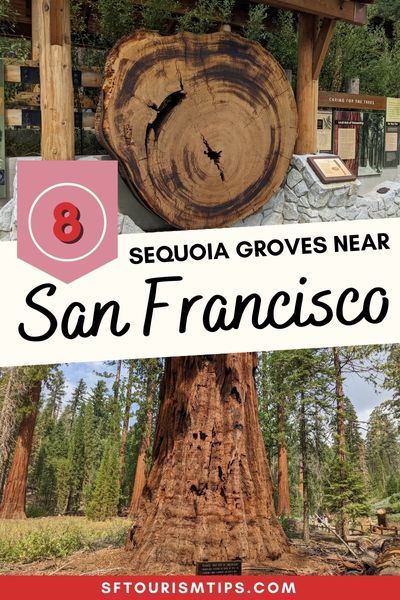SIGN UP FOR MY EMAIL TO RECEIVE YOUR FREE SAN FRANCISCO PLANNING GUIDE.
Sequoia Trees Near San Francisco: 9 Great Groves to Explore
By: Jill Loeffler • Updated: August 24, 2025
Are you searching for places to see towering Sequoia trees near San Francisco? You'll find these giants about four hours east of the Bay Area along the western slopes of the Sierra Nevada Mountains.
My guide explains the difference between sequoias and Coastal Redwoods, the best places to find them, and a few other details about these historic trees.
SFTourismTips is made possible by readers like you! If you book through my links, I may earn a small commission at no extra cost to you. Thanks for your support! Learn more.
Sequoias vs. Coastal Redwoods
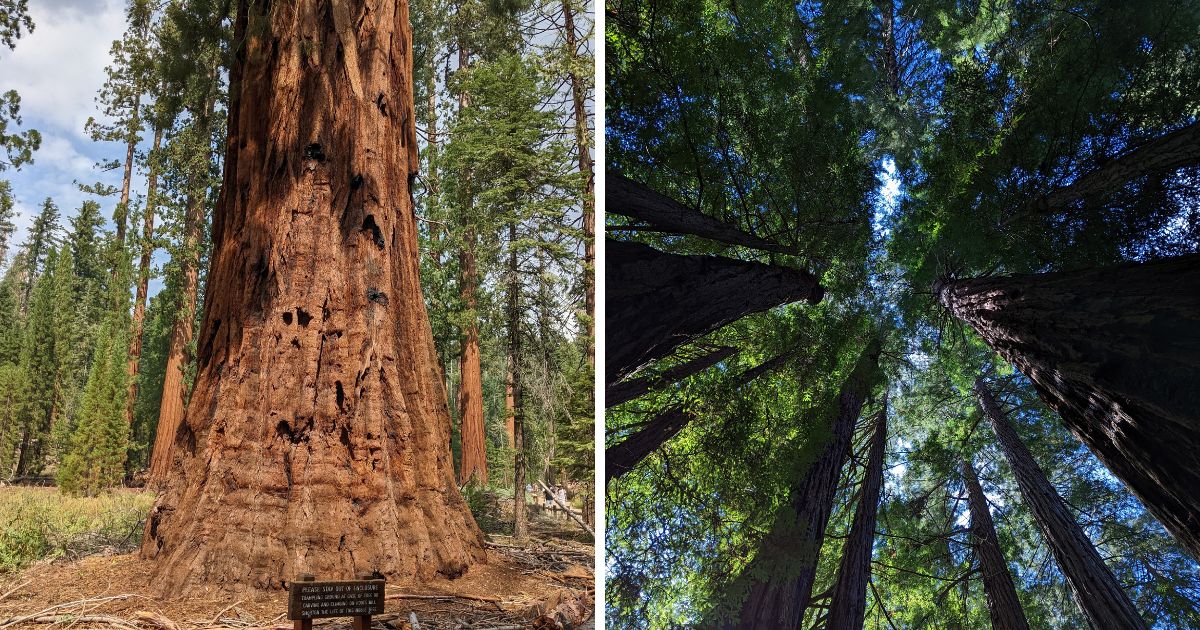 The one on the left is the base of a giant sequoia in Yosemite. The one on the right is a group of Coastal redwoods in Muir Woods.
The one on the left is the base of a giant sequoia in Yosemite. The one on the right is a group of Coastal redwoods in Muir Woods.There is little in nature to match the sheer majesty of either the Giant Sequoia or the Coastal Redwood tree. You may have believed they were the same—as many people do—but they are two distinct species from the Redwood family. What are the differences?
The Giant Sequoia grows naturally on the western slopes of California's Sierra Nevada mountains. It is found only within a 60-mile band of conifer forest in the mountains.
It is the widest tree in the world in girth, but not the tallest. That accolade goes to its close relative.
Coastal Redwoods are the tallest trees in the world and can grow to a height of over 300 feet. They are found along the coast of California from the northern edge of the state to the Big Sur region.
In Short... (No Pun Intended)
Giant Sequoia
- shorter, wider
- grows in mountains
- larger pinecones
- lives hundreds of years
Coastal Redwood
- taller, thinner
- grows on coast
- smaller pinecones
- lives hundreds of years
If it turns out it's redwoods you're after, look no further than my favorite redwood spots near San Francisco and my favorite redwood parks near Monterey. There are many places to admire these towering beauties that are just a short distance from the city, rather than a 4+ hour drive inland.
Yosemite National Park
The world-famous Yosemite National Park, a designated World Heritage Site, is famous for its diverse landscape, flora, and fauna. Some of the main attractions of the nearly 1,200-square-mile park are three superb groves of Sequoia.
Surrounded by the Sierra and Stanislaus National Forests, Yosemite is 95% designated wilderness. It is open year-round and, with 800 miles of trails, is very popular with hikers as well as climbers.
Great Guided Tours to Explore Yosemite
1. Mariposa Grove
The largest of the Sequoia groves in Yosemite, Mariposa Grove is home to more than 500 of the best examples of the species.
Highlights
- Trails for all levels: Big Trees Loop (0.3 mi, accessible), Guardians Loop and Mariposa Grove Trail (moderate to strenuous)
- Can't-miss attractions: The Wawona Tunnel Tree (fallen), The Bachelor, and The Three Graces
- Visitor amenities: restrooms at Welcome Plaza, but no food outlets—bring a picnic
Know Before You Go
- Dogs not allowed in the grove
- Seasonal shuttle available (except in winter when roads close)
- Parking is limited to 300 spots that usually fill up by midday, so arrive early
>> More about visiting Mariposa Grove
2. Tuolumne Grove in Yosemite
This special grove is quite remote and only offers a couple-dozen Giant Sequoias. However, these mature trees are hundreds of years old and are truly spectacular.
Highlights
- Main 1.5-mile walking trail through the grove (moderate uphill on return)
- Winter option: 2.5-mile ski/snowshoe route for adventurous visitors
- Peaceful, less crowded alternative to Mariposa Grove
Know Before You Go
- Wheelchair access not available, no bicycles allowed
-
Dogs permitted only on paved paths, not on dirt trails
- Parking is very limited
3. Merced Grove in Yosemite
With around 20 magnificent standing Giant Sequoias, Merced Grove is the smallest of Yosemite's three Sequoia groves, accessible only on foot for an unforgettable experience.
Highlights
- Historic ranger cabin adds cultural and historical interest to the visit
- Remote grove—ideal for solitude and nature lovers
Know Before You Go
- Trails for hikers only; no dogs or bikes; not wheelchair accessible
- No facilities—bring water and snacks for your visit
Sequoia and Kings Canyon National Parks
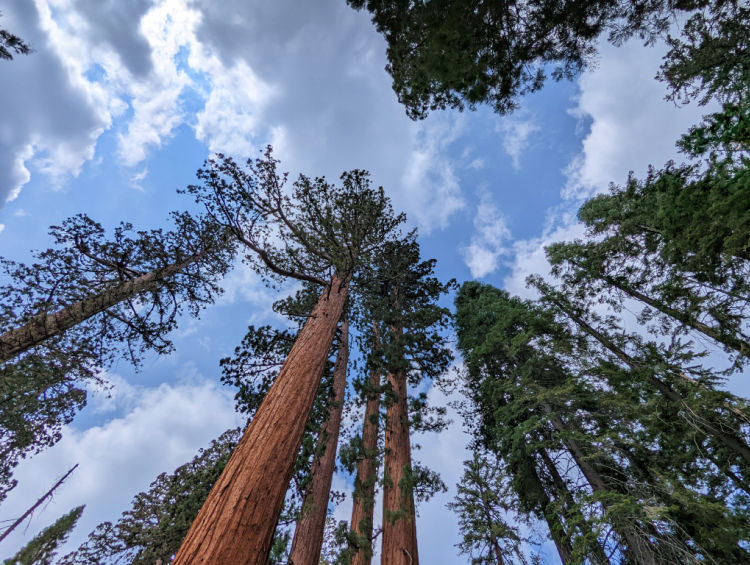 As the sequoia grows and becomes part of a mixed conifer forest, which only happens naturally here in the Sierra Nevada Mountains, they tend to be the least numerous species in the groves, but their sheer size makes them the most dominant and awe-inspiring.
As the sequoia grows and becomes part of a mixed conifer forest, which only happens naturally here in the Sierra Nevada Mountains, they tend to be the least numerous species in the groves, but their sheer size makes them the most dominant and awe-inspiring.Sequoia and Kings Canyon National Parks are managed by the same organization but are two distinct parks. Giant Sequoias can be seen in both, with a choice of groves to experience.
The parks have identified 40 groves within the boundaries, with some featuring thousands of these astonishing trees!
>> This is a fantastic self-guided audio tour for your visit to Kings Canyon
4. Giant Forest in Sequoia National Park
The most visited grove in the Sequoia National Park is the aptly named Giant Forest. It's home of the famous General Sherman Tree, the largest living tree on earth.
Highlights
- General Sherman Tree: 36 feet wide, 275 feet tall
- Historic cattle grazing structures
- Giant Forest Museum for insight into the region's history and culture
Know Before You Go
- Wheelchairs can access the General Sherman Tree
- Hiking trails that vary from 1 to 2 hours to half a day
- Shuttle buses available from summer through fall
- Parking lots near trails fill up quickly
5. Grant Grove in Kings Canyon
The most popular sequoia grove in Kings Canyon is Grant Grove, home of the magnificent General Grant Tree, famously celebrated yearly as the "Nation's Christmas Tree."
Highlights
- General Grant Tree (second-largest sequoia by volume)
- Gamlin Cabin (historic homestead)
- Fallen Monarch (massive hollow tree, down for 300+ years)
Know Before You Go
- 1/3-mile paved loop that takes in the General Grant and other attractions
- Trails available for deeper exploration of the 90-acre grove
- Shuttle buses in summer from visitor centers and campgrounds
6. Redwood Mountain Grove
Within Kings Canyon National Park, the Redwood Mountain Grove used to be one of the largest groves of giant sequoia trees in the world. Sadly, 40 percent of the grove burned in the massive fire of 2021, and many Giant Sequoias were killed.
While there are signs of Sequoia seedling regeneration and re-sprouting of wildflowers and shrubs in more open forests now, the trail remains closed until further notice due to hazardous conditions. We advise potential visitors to check in advance.
When Redwood Mountain reopens, visitors will access many miles of exciting and rewarding loop trails.
The Surprising Relationship Between Sequoias and Fire: Sequoias actually need fire to open their cones and release their seeds. Fires help clear the underbrush so the trees can have the space and sunlight they need to grow. Their trunks are almost always marked by fire scars at ground level. Their living limbs and needles grow hundreds of feet above the forest floor, where they are safe from most flames.
7. Muir Grove
Muir Grove is another Sequoia grove affected by the fire that tore through the region in 2021. However, firefighters successfully prevented more severe damage, and the grove remains open for visitors.
Quieter in terms of visitor numbers than other groves in these parks, Muir Grove is worth a visit for the many enjoyable hiking trails.
Look across the creek gorge east of the grove for a spectacular view. There is ample camping close by for those who want to spend more time in this tranquil and fascinating grove.
Calaveras Big Trees State Park
Calaveras Big Trees State Park, a few miles from the town of Arnold in the Sierra Nevada Mountains, is considered the longest continually operating tourist attraction in California.
Welcoming visitors since 1852, it offers access to two stunning sequoia groves.
8. North Grove
Highlights
- About 100 mature Sequoias
- Historic Pioneer Cabin Tree: once a living tunnel tree, collapsed in 2017
- Empire State Tree: massive, 30-foot diameter
Know Before You Go
- Easy to access year-round (even in winter, on foot when roads are closed)
- Family-friendly: great option for a shorter walks
- Dogs allowed on leash in some areas (but not on trails)
9. South Grove
Highlights
- Large size: home to ~1,000 sequoias
- Lois Agassiz: tallest tree in the park at 250 feet
- Palace Hotel Tree: second largest, visitors can walk inside its burn scar
Know Before You Go
- More extensive hiking, with moderate-to-strenuous trails
- Less crowded and feels wilder than North Grove
- Road access closed in winter; accessible by hiking/snowshoeing
In either grove, activities include evening talks by park rangers, picnic areas, and activities for children.

Hi, I’m Jill!
I’ve been sharing San Francisco travel advice since 2009 and have helped millions of people explore the city like a local. Whether you’re dreaming of sea lions, cable cars, or a great sourdough bread bowl, I’m here to help you plan an unforgettable trip with real tips from someone who actually lives here.
Comments? Questions? Suggestions?
I would love for you to join me in my private Facebook group!
It's a great place to interact with me and others who are familiar with the area.
You can ask questions, get advice for your upcoming stay, and then share your photos and advice with others when you return home. It's a great community and the fastest way to get answers to those nagging questions about your visit!
